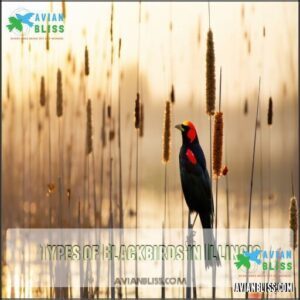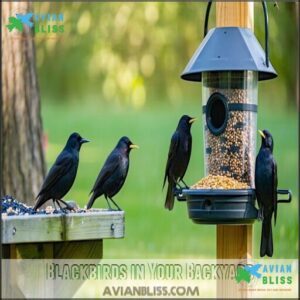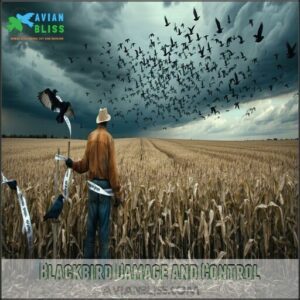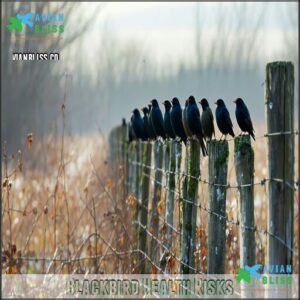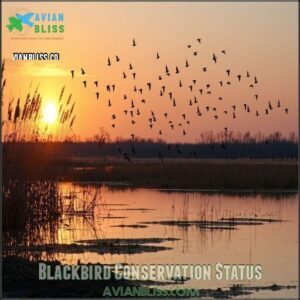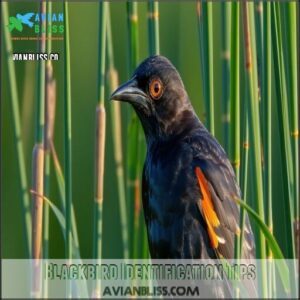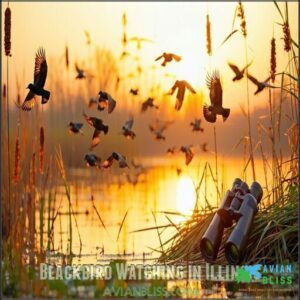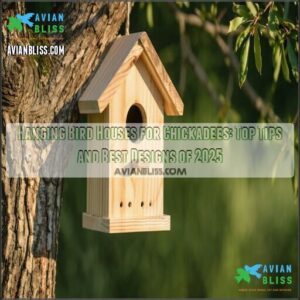This site is supported by our readers. We may earn a commission, at no cost to you, if you purchase through links.
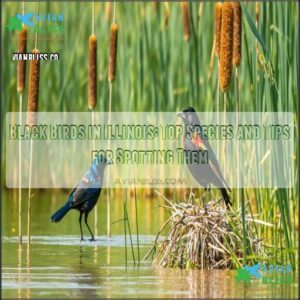 Illinois hosts an array of fascinating black birds that bring life to its landscapes.
Illinois hosts an array of fascinating black birds that bring life to its landscapes.
You’ll often see red-winged blackbirds flashing their bold red and yellow shoulders near wetlands, while common grackles strut around like they own the place, their glossy feathers shimmering in the sunlight.
Brown-headed cowbirds, known for freeloading off other birds’ nests, add a touch of mischief.
Don’t overlook the rusty blackbirds, whose numbers are sadly declining, or the rare yellow-headed blackbirds with their striking appearance.
Whether in a backyard or wetland, these birds are as diverse as Illinois itself—and there’s always something new to learn about them.
Table Of Contents
- Key Takeaways
- Types of Blackbirds in Illinois
- Blackbirds in Your Backyard
- Common Black Birds in Illinois
- All-Black Birds in Illinois
- Red-winged Blackbird Behavior
- Blackbird Damage and Control
- Blackbird Health Risks
- Blackbird Conservation Status
- Blackbird Identification Tips
- Blackbird Watching in Illinois
- Frequently Asked Questions (FAQs)
- Are there Blackbirds in Illinois?
- What does a blackbird look like in Illinois?
- Are Brewer’s blackbirds common in Illinois?
- Is there a more beautiful black bird in Illinois?
- Are rusty blackbirds a problem in Illinois?
- Why are blackbirds declining in Illinois?
- What kind of blackbirds are in Illinois?
- Are blackbirds good to be in your yard?
- Why are black birds in my backyard?
- Are red winged blackbirds common in Illinois?
- Conclusion
Key Takeaways
- You’ll find diverse blackbirds in Illinois, like Red-winged Blackbirds, Common Grackles, Brown-headed Cowbirds, and Rusty Blackbirds, thriving in wetlands, grasslands, and urban spaces.
- Protect wetland habitats to help species like Rusty and Yellow-headed Blackbirds, which face sharp population declines due to habitat loss.
- Attract blackbirds to your yard by offering seeds, a birdbath, and native plants while keeping feeders secure from predators.
- Watch for migration patterns, especially in spring and fall, when massive flocks of blackbirds stop at Illinois wetlands for rest and food.
Types of Blackbirds in Illinois
You’ll find a surprising variety of blackbirds in Illinois, each with unique features that make them stand out.
From the flashy Red-winged Blackbird to the rare Yellow-headed Blackbird, there’s plenty to watch for if you know what to look for.
Red-winged Blackbirds
The Red-winged Blackbird is a true showstopper in Illinois’ Wetland Habitats. Males wear jet-black feathers accented with bold red-and-yellow shoulder patches, while females keep it subtle with streaked brown Plumage Variations that blend perfectly for nesting.
You can’t miss their signature “conk-la-ree!”—a call that’s both a serenade and a warning to rivals. These black birds of Illinois are fiercely territorial, defending their space like it’s prime real estate.
Red-winged Blackbirds adapt well to seasonal shifts, dining on seeds in cooler months and switching to insects in summer. They’re also among the first birds to arrive each spring, filling marshy landscapes with life and sound.
- Prefer marshes, meadows, and water edges.
- Migrate in massive, eye-catching flocks.
- Essential for monitoring ecosystems and Conservation Status.
- Recognizable by bold colors and proud Vocalizations.
Common Grackles
Among common black birds in Illinois, the Common Grackle shines—literally. Their Grackle Iridescence flashes hints of purple and bronze in sunlight, with their wedge-shaped tail and sharp yellow eyes adding to their drama.
These urban grackles are bold opportunists, snagging scraps and raiding feeders. Their scratchy, rusted-gate calls make them impossible to miss.
You’ll spot them in flocks, from backyards to fields, thriving on a diverse grackle diet.
Despite their confidence, they face a population decline, making their dynamic presence within black bird species worth appreciating before they flock away.

Brown-headed Cowbirds
Brown-headed Cowbirds aren’t your typical parents—they’re brood parasites, outsourcing child-rearing to over 200 host species.
Males show off glossy black bodies with brown heads, while females keep it simple in shades of brown.
You’ll often spot them near grazing cattle.
Here’s what to know:
- Brood Parasitism: Laying eggs in other birds’ nests impacts native species.
- Range Expansion: Thrives in human-altered landscapes.
- Nesting Habits: Evolutionary strategies at work!
Rusty Blackbirds
The Rusty Blackbird stands out as one of the most unique black birds in Illinois.
Often overlooked, these birds are known for their remarkable rusty-edged feathers in fall and haunting, bubbly calls.
They depend on wetland breeding grounds, which are rapidly disappearing due to habitat loss.
Listed on the IUCN Red List, their population decline is alarming—over 90% since the 1970s.
| Trait | Detail |
|---|---|
| Size | 8.3–9.8 inches long |
| Distinctive Feature | Rusty plumage, pale yellow eyes |
| Breeding Habitat | Forested wetlands |
| Winter Location | Southeastern U.S. |
| Migration Timing | Starts in September |
Brewers Blackbirds
Brewer’s Blackbirds are sleek, glossy beauties with striking yellow eyes, often seen in Illinois fields, pastures, and parks.
Their plumage variations shimmer with purple and green, adding flair to their social behavior.
These black birds love open spaces and thrive on waste grain, seeds, and insects.
During nesting season, they craft grass and mud nests in tight colonies.
If you’re into Illinois bird identification, their cheerful "kee-see" calls make spotting this black bird species a memorable treat.
Males showcase iridescent plumage hues in the right light.
Yellow-headed Blackbirds
The Yellow-headed Blackbird is a striking highlight for anyone exploring black bird species in Illinois.
Their flashy yellow heads and black feathers make them an unforgettable sight, though their wetland dependence means you’ll only find them in specific habitats.
- Search cattail-filled marshes during migration.
- Listen for their raspy, “rusty hinge” mating calls.
- Focus on northern Illinois’ wetlands for active nesting sites.
- Watch for their foraging flocks in fields and around water.
Preserving their urgent conservation needs highlights the importance of protecting their habitats, which is crucial for the Yellow-headed Blackbird to survive in their wetland environments, and ensuring their black bird species thrive.
Blackbirds in Your Backyard
You might already have a few blackbirds visiting your backyard, especially if you’ve got trees, shrubs, or a feeder full of seeds.
These adaptable birds are fascinating to watch as they search for food, call to their mates, and even squabble over territory, which makes them fascinating to observe, and their behavior can be quite adaptable.
Attracting Blackbirds to Your Yard
Want to attract black birds in Illinois? Make your yard irresistible with a few simple bird attraction tips.
Start with a bird bath—fresh water is a magnet, especially during hot summers. Blackbirds also love certain bird food types like cracked corn, dried fruits, and suet.
Use bird feeder strategies like tray feeders that are easy for them to spot and access. Plant native greenery, like sunflowers or berry-producing shrubs, to provide food, shelter, and nesting materials.
Adding a bird bath can substantially increase the number of birds visiting your yard. Need better predator control? Add dense bushes or hedges for safe hiding spots.
Keeping your yard tidy but natural with shelter options encourages blackbird visits. Trust this: your space will soon be alive with bird sounds and charm!
Blackbird Diet and Feeding Habits
Blackbirds are like nature’s food critics, flexing their foraging strategies for a balanced bird diet year-round.
Their seasonal diet is as versatile as their habitats, featuring a mix of seeds, insects, fruits, and grains. With their adaptive bird foraging behavior, these Illinois blackbirds thrive by making the most of available food sources.
Here’s the menu for your backyard buffet:
- Insect consumption: Protein-rich beetles, grubs, and caterpillars.
- Seed preference: Black oil sunflower seeds—high-energy favorites.
- Fruit options: Apples, berries, and dried fruits for a sweet treat.
- Grain choices: Cracked corn and oats—ideal for hearty meals.
- Fresh water: A birdbath quenches their thirst and supports foraging.
Keep it fresh, and your guests won’t leave hungry!
Blackbird Nesting and Breeding Habits
Spring’s a busy time for bird nesting habits, especially with Illinois’s black birds. Males claim the best spots, dazzling females with their bold displays. Once paired, females take over, weaving incredible nests from twigs, grasses, and mud. It’s crafty, messy, and impressive work!
Each clutch size is 3-6 eggs, incubated for 12-14 days. Hatchlings depend on dedicated fledgling care before they’re ready to fly.
You’ll spot clever nesting behaviors in these places:
- Tucked into cattails or reed beds near wetlands
- Hidden in shrubs by streams or ponds
- Perched high on tree branches over water
- Surrounded by tall, damp meadow grasses
- Securely woven within marsh edges
Blackbird Migration Patterns
Black bird migration patterns are nature’s roadmap.
Migration triggers like food shortages and shorter days push species to their seasonal homes. Red-winged Blackbirds start migrating early, while Rusty Blackbirds follow a month later.
Stopover habitats along flyway routes, like Illinois marshes, offer rest and food. Climate impacts and habitat loss can shift bird migration timing.
Watching these rhythmic flocks feels like catching nature’s orchestra in motion.
| Species | Migration Time | Flyway Route |
|---|---|---|
| Red-winged Blackbird | January-March | Mississippi Flyway |
| Rusty Blackbird | February-April | Eastern/Mississippi |
| Brewer’s Blackbird | September-November | Central Flyway |
Common Black Birds in Illinois
Illinois boasts incredible habitat diversity, perfect for common black birds.
These bold beauties add life to wetlands, backyards, and beyond. Their varied plumage and fascinating behaviors make them a joy to spot.
Who might you see?
- Red-winged Blackbird: Striking red-and-yellow shoulders; fiercely protective parents.
- Common Grackle: Glossy feathers shimmer in sunlight; clever and curious.
- Brown-headed Cowbird: Sneaky brood parasites, using other birds’ nests.
- Rusty Blackbird: Seasonal migrants, with warm plumage tones in fall.
- European Starling: Quick adapters, dazzling in urban settings.
Feeding ecology is key—offer seeds or suet to encourage visits from these characters!
All-Black Birds in Illinois
What makes black birds in Illinois such fascinating characters? Their all-black feathers may appear simple, but look closer—there’s magic in the details.
- Common Grackles stun with iridescence, their feathers shimmering blue, purple, or bronze like sunlight on oil.
- European Starlings, often mistaken for melanistic blackbirds, feature speckled black feathers in winter and sharp yellow beaks in summer.
- Rusty Blackbirds showcase seasonal charm, with males flaunting rusty-brown highlights during migration.
- Brewer’s Blackbirds are sleek, their glossy black feathers offset by fierce yellow eyes reflecting green and purple tones.
These types of black birds highlight nature’s diversity. Whether it’s spotting a grackle’s sheen or comparing raven vs. crow profiles, the mystery keeps you looking!
Red-winged Blackbird Behavior
You’ll notice red-winged blackbirds are like tiny marshland warriors, fiercely protecting their nests from anything that gets too close.
Their flashy colors and bold calls also play a key role in defending territory and attracting mates, which can be seen as a form of defending territory.
Aggressive Defense of Nests
Red-winged blackbirds make it clear when you’ve stepped into their turf. These bold defenders use sharp calls, aerial maneuvers, and even direct charges to protect their nests from threats.
Their territoriality displays show a surprising mix of strategy and fearlessness, deterring predators and rival birds alike. They’re known for safeguarding food sources to guarantee their offspring thrive.
Here’s a glance at their defensive tactics:
| Behavior | Purpose | Targets | Fun Fact |
|---|---|---|---|
| Sharp vocalizations | Warn intruders | Predators, humans | Calls vary by threat type |
| Aerial dives | Intimidate intruders | Birds, mammals | Males dive more than females |
| Chasing predators | Remove threats entirely | Other birds, small mammals | Often chase larger animals |
| Nest concealment | Avoid detection | Sneaky predators | Built in dense vegetation |
They’ve mastered nesting defense strategies, showing how powerful parental investment can be. Tempt fate? You’ll get a feisty escort out!
Mating Habits and Territory
Male Red-winged Blackbirds are the ultimate show-offs during the breeding season.
Their secret weapon? Those vivid red-and-yellow shoulder patches.
They’re like flashing neon signs in a diner, catching your eye from far away.
These bold displays, paired with loud, musical calls, serve two big purposes: attracting mates and standing their ground in fierce territory defense.
When it comes to bird territorial behavior, these guys don’t mess around.
A single male can claim up to 2,000 square meters.
Within that space, he’s the boss, often sharing his “turf” with several nesting females.
Think of it as running a luxury resort, but the guests stay rent-free while raising their broods.
Mating rituals are equally dramatic.
Their calls and flared wings are all about proving dominance and wooing females.
This intense black bird behavior offers a fascinating glimpse into how black birds in Illinois defend and thrive in their territories.
Diet and Foraging Habits
In terms of their black bird diet, Red-winged Blackbirds keep things flexible and seasonal.
Their bird feeding habits change to stay well-fed year-round:
- Seed Preference: Grasses and grains dominate their Winter Diet.
- Insect Consumption: Beetles and caterpillars rule their summer menu.
- Berries: Sweet snacks appear occasionally.
- Foraging Locations: You’ll spot them on the ground or tree-hopping.
- Food Competition: Cornfields can turn into bird buffets for them.
Impact on Illinois Ecosystem
You might think of red-winged blackbirds as tiny marsh superheroes. These black birds in Illinois thrive in wetlands, eating insects and helping with insect control, which keeps pest populations down.
They also support wetland health by spreading seeds, keeping plant life diverse. However, habitat destruction disrupts their role and contributes to bird population decline.
Brood parasitism by brown-headed cowbirds and competition impacts with invasive species challenge their survival, too. Protecting bird habitats guarantees the balance of Illinois’s ecosystems.
Bird conservation isn’t just for the birds—it’s for nature’s harmony and our future.
Blackbird Damage and Control
Blackbirds can cause serious problems for farmers, especially when large flocks feed on crops or damage fields.
You can manage their impact by using repellents, scare tactics, and other non-lethal methods to keep them away without harming them, which is a key aspect of managing their presence effectively.
Agricultural Damage Prevention
When blackbirds in Illinois turn your crops into an all-you-can-eat buffet, it’s time to act smart.
Protecting fields from these clever agricultural pests doesn’t have to feel impossible.
- Crop Protection: Netting solutions work wonders for high-value crops like berries or sunflowers.
- Scare Tactics: Use reflective tape, noisemakers, or even inflatable predators to keep blackbirds guessing.
- Habitat Modification: Trim sheltering vegetation near fields to reduce bird attractions.
- Chemical Repellents: Approved sprays can make plants less tasty, discouraging bird foraging.
Don’t let these opportunistic eaters snack on your hard work!
USDA-APHIS-Wildlife Services Reports
If you’re dealing with black bird issues in Illinois, the USDA-APHIS-Wildlife Services has your back.
They’ve mastered balancing crop protection with the ecosystem’s needs. Their reports rely on precise data collection and guarantee report accuracy to guide farmers in addressing damage caused by species like red-winged blackbirds, common grackles, and even American crows.
Their mitigation strategies include habitat removal, like vegetation clearing, to reduce nesting sites. Need immediate help? They suggest frightening devices (think noisy pyrotechnics) to scatter flocks, especially during migrations.
For overpopulation, population control methods target problem species, ensuring minimal impact on others. Through evaluations and customized strategies, USDA-APHIS tackles problems scientifically, easing public concerns while influencing positive policy impacts.
With these resources, managing Illinois bird species isn’t challenging—it’s science-backed teamwork!
Non-Lethal Deterrents and Repellents
Tired of black birds in Illinois turning your yard into their playground? Let’s stop them in their tracks—peacefully! Visual deterrents like shiny tape or pinwheels mess with their focus, while audio repellents such as wind chimes or sonic devices confuse their instincts.
Habitat modification works wonders; remove food sources and keep feeders clean. Exclusion methods, like garden netting, shield plants from hungry birds. For bold birds, try bird repellents such as taste sprays or bird scarecrows. One smart tip? Stay unpredictable—birds adapt quickly!
Consider using specialized bird deterrents for persistent problems.
- **Try hanging reflective tape in problem areas to disrupt bird behavior with flickering light.
Scare them—without breaking the peace.
Blackbird Health Risks
Blackbirds might look harmless, but their droppings can carry harmful bacteria like Salmonella and E. Coli. You’ll want to stay cautious, especially in areas where large flocks gather.
Salmonella and E. Coli in Bird Droppings
Bird droppings aren’t just an eyesore—they can carry pathogens like Salmonella and E. coli, putting you and others at risk.
These Dropping Contamination Risks can lead to stomach upset, respiratory issues, or property damage if ignored. Disease Transmission Vectors, such as airborne particles, increase the Public Health Impact, especially when droppings dry and crumble.
These droppings can even transmit over 60 diseases.
To stay safe, practice Cleaning Best Practices. Use gloves, masks, and a disinfectant when handling droppings. Rinse surfaces with soapy water or vinegar to prevent stains and germs.
Wet the droppings first to avoid inhaling particles.
Prevention Strategies also help: clean bird feeders weekly and keep bird-friendly areas tidy. While enjoying Illinois’s bird species, remember that understanding bird behavior and habitats includes staying cautious about their mess!
Bird-Aircraft Strikes and Safety Concerns
Flights and bird flocks don’t mix well—especially near bustling airports like O’Hare and Midway, where over 430 bird-aircraft strikes happen yearly.
These incidents are costly and dangerous, but Illinois uses clever mitigation strategies to reduce risks:
- Strike Risk Factors analyzed via radar tools.
- Altering nearby habitats to resist nesting.
- Real-time alerts for pilots during migration seasons.
- Disturbance tactics like loud sounds or patrol dogs.
- Improved training on reporting procedures to agencies.
Blackbirds are essential to ecosystems, but safe skies mean peaceful coexistence.
Human Health Risks and Precautions
Large flocks of blackbirds in Illinois might look stunning, but they can cause issues if you’re not careful.
Bird droppings often carry pathogens like Histoplasmosis or Salmonella, which can affect your health. Always wear protective gear when cleaning areas with droppings, especially in public spaces or near nesting spots.
Good air quality matters—use masks to avoid inhaling dust. If handling birds, protect against disease transmission and bird bites. Quick action helps keep bird habitats in Illinois safe for everyone.
| Risk | Cause | Precaution |
|---|---|---|
| Respiratory Issues | Histoplasmosis | Wear a mask |
| Food Contamination | Salmonella | Wash hands |
| Toxic Exposure | E. coli | Gloves & sanitation |
| Allergies | Dust/Mites | Use protective gear |
| Zoonotic Diseases | Avian Flu | Report outbreaks |
Always prioritize bird conservation efforts!
Blackbird Conservation Status
Blackbirds in Illinois face different challenges, from habitat loss to declining populations. Learning about their conservation status helps you understand how to protect these unique birds for future generations.
Red-winged Blackbird Population Trends
Watching red-winged blackbirds flashing their bright crimson shoulder patches, it’s easy to think their numbers are solid.
But recent population trends in Illinois reveal a subtle decline, especially in urban and heavily farmed areas.
These black birds balance steady numbers in wetlands, adapting to habitat loss, yet they’re not immune to challenges like climate change and pesticide use.
Here are highlights of the Redwinged Blackbird’s story:
- Habitat loss forces them to nest in hayfields and roadside marshes.
- Seasonal migrations form massive flocks still awe-inspiring.
- Predation impact increasingly pressures breeding colonies.
- Conservation strategies play a pivotal role, but challenges remain.
Rusty Blackbird Conservation Efforts
Rusty Blackbirds, once plentiful, have seen a staggering 85-90% population decline, but there’s hope within Illinois.
Rusty Blackbirds, facing a sharp decline, still find hope in Illinois’s wetlands through conservation and thoughtful habitat restoration.
Conservation groups focus on reversing this trend through Habitat Restoration and Population Monitoring.
Wetland Preservation is key since these black birds rely on Illinois’s marshy stopovers during migration.
Efforts like restoring wetlands at Glacial Park Conservation Area aim to tackle Migration Threats and reconnect essential habitats.
You can get involved by reporting Rusty Blackbird sightings on eBird or supporting wetland-friendly initiatives.
Small actions like these boost Public Awareness and strengthen bird conservation efforts, improving wetland habitats and giving these unique birds a fighting chance.
Yellow-headed Blackbird Habitat Preservation
The Yellow-headed Blackbird is hanging by a thread in Illinois, relying on fragile wetland habitats that are rapidly shrinking.
These wetlands are more than just puddles; they’re lifelines for this spectacular species.
You can make a difference with a little effort:
- Advocate for Wetland Restoration to reverse habitat loss.
- Push back against Habitat Fragmentation caused by unchecked development.
- Support Conservation Strategies, like invasive species control in wetlands.
- Visit wetland preserves to encourage Population Monitoring programs.
Saving the Yellow-headed Blackbird starts with protecting the delicate balance of these watery worlds!
Blackbird Identification Tips
You can spot blackbirds by focusing on their distinct features like color patterns, body shape, and eye color.
Listen for their unique calls and look in their favorite habitats, like wetlands and fields, for the best chances to identify them.
Visual Identification Characteristics
Spotting black birds in Illinois is easy, but identifying specific species takes a closer look. You’ll be their detective, deciphering plumage and shape clues to match them to names.
Start with plumage iridescence. In good light, a Common Grackle flashes metallic blue-green, while a Red-winged Blackbird flaunts fiery red shoulder patches.
The beak shape matters too. Cowbirds have short, chunky beaks, ideal for cracking seeds, while Rusty Blackbirds have slimmer, pointy beaks.
Look carefully at eye color. Brewer’s Blackbird males boast striking yellow eyes. Grackles halo their yellow eyes with a stern expression.
Then check body size and tail features. Starlings are small and squat, but Grackles carry long, wedge-shaped tails and a lean frame.
Vocalization and Call Patterns
Identifying black bird sounds is like tuning into nature’s podcast.
Red-winged Blackbirds sing their bold "konk-la-ree" near wetlands, while Common Grackles share harsh, creaky notes.
Some species even show off mimicry abilities or unique regional dialects.
These bird songs and calls aren’t just fun to hear—they serve call functions like territory defense, attracting mates, or group chatter.
With practice, their vocal learning makes recognizing these bird vocalizations a rewarding skill.
Habitat and Distribution Clues
When you’re out looking for black birds in Illinois, knowing their favorite spots makes all the difference. Each species has unique bird habitat preferences across the state.
- Red-winged Blackbirds love wetland habitats like marshes, ponds, and cattail-lined edges.
- Common Grackles thrive in suburban areas, agricultural edges, and open woodlands.
- Brown-headed Cowbirds stick to grasslands and forest edges, searching for host nests.
Seasonal changes mix things up. In fall and winter, black birds in Illinois often gather in enormous flocks across open fields. By spring, they’re busy defending nesting territories, showing off their range expansion and adaptability to habitat loss.
Blackbird Watching in Illinois
You’ll love the thrill of spotting Illinois’s diverse blackbirds in open fields, wetlands, and even your backyard.
Grab your binoculars and enjoy their vibrant songs and fascinating behaviors during migration or nesting seasons.
Best Places to Spot Blackbirds
Illinois offers fantastic birdwatching locations for black bird sightings.
Explore Wetland Hotspots like Montrose Point Bird Sanctuary and Illinois Beach State Park for Seasonal Abundance.
Urban Sanctuaries near Chicago parks are teeming with action.
Prairie Ridge State Natural Area showcases Habitat Diversity with stunning species.
| Location | Best Time | Habitat |
|---|---|---|
| Montrose Point | Early morning | Wetlands |
| Illinois Beach Park | Midday | Marshes |
| Prairie Ridge | Dawn/dusk | Grasslands |
| Local Parks | Morning | Urban areas |
| Suburban Forests | Afternoon | Mixed woods |
Spring and Fall Migration Patterns
Each spring, Illinois witnesses the grand arrival of blackbirds, signaling nature’s clock is ticking. Red-winged Blackbirds, often spring’s early heralds, arrive in late February, filling wetlands with bold calls.
By April, you’ll notice mixed flocks of Common Grackles and Brown-headed Cowbirds establishing territories across marshes, meadows, and fields.
Come fall, the spectacle continues as millions of Rusty Blackbirds pass through Illinois, often gathering at dusk in dazzling roosts. Scientists studying migration triggers have observed a shift in timing—birds now arrive 5-7 days earlier than they did decades ago, likely influenced by climate impact on migration timing.
These routes are known as major bird flyways, connecting breeding and wintering grounds.
- Watch for stopover habitats near lakes and forests, where migratory birds pause along their flyway routes.
Tips for Attracting Blackbirds to Your Yard
After spotting flocks, why not convince them to settle in your yard? Black birds in Illinois flock to cozy habitats offering food, water, and shelter.
- Seed Choices: Use sunflower seeds and cracked corn on sturdy bird feeders.
- Water Features: A shallow birdbath attracts thirsty visitors.
- Roosting Spots: Plant native shrubs like dogwood for nesting.
- Nesting Materials: Leave small piles of twigs or grass nearby.
- Birdbath Placement: Keep it visible yet safe from predators.
Offering quality seeds for birds can substantially increase their attraction to your yard. Welcome them properly, and you’ll enjoy effortless birdwatching!
Frequently Asked Questions (FAQs)
Are there Blackbirds in Illinois?
You’ll find plenty of blackbirds in Illinois, from Red-winged Blackbirds with their flashy wing patches to Common Grackles and Brewer’s Blackbirds.
They thrive in wetlands, grasslands, and urban spaces, adding charm to diverse landscapes.
What does a blackbird look like in Illinois?
It’s fascinating how nature paints its own masterpieces.
In Illinois, blackbirds often showcase glossy black feathers, sometimes iridescent blues or purples.
Males stand out, while females lean in the direction of brown tones with streaks, showcasing a unique aspect of nature’s masterpieces.
Are Brewer’s blackbirds common in Illinois?
You’ll spot Brewer’s blackbirds occasionally in Illinois, though they’re more common in open spaces out west.
They love grasslands and urban areas, so keep an eye out near parks or fields—they’re not shy!
Is there a more beautiful black bird in Illinois?
Beauty is in the eye of the birder, but the Red-winged Blackbird’s fiery red and yellow shoulders steal the show in Illinois wetlands, outshining even the Common Grackle’s glossy feathers.
Nature’s designs never disappoint!
Are rusty blackbirds a problem in Illinois?
Rusty blackbirds aren’t causing problems in Illinois but face big challenges themselves.
Their population has dropped by 85% over 40 years due to habitat loss.
Preserving wetlands is key to helping this struggling, yet fascinating species thrive.
Why are blackbirds declining in Illinois?
Like a collapsing bridge, blackbird populations in Illinois are falling due to habitat loss, drained wetlands, and environmental changes.
You’ll find them struggling as wetlands disappear, climate shifts, and food sources shrink rapidly, which is a result of environmental changes.
What kind of blackbirds are in Illinois?
You’ll find various blackbirds in Illinois, like Red-winged Blackbirds, Common Grackles, Brown-headed Cowbirds, Rusty Blackbirds, and Brewer’s Blackbirds.
Each has unique colors, songs, and habits, thriving in wetlands, meadows, or urban spaces, which showcases their ability to adapt to different environments with distinct habits.
Are blackbirds good to be in your yard?
Having blackbirds in your yard can be great for pest control since they eat insects, but they might snack on seeds too.
Their songs add charm, though large flocks could cause noise or mess.
Why are black birds in my backyard?
Blackbirds visit your yard for food, shelter, or nesting space.
They’re drawn to seeds, insects, or nearby water.
If you’ve got trees or a bird feeder, it’s basically an open invitation for them!
Are red winged blackbirds common in Illinois?
Imagine a sunrise over marshes dotted with lively chatter—those are red-winged blackbirds.
They’re very common in Illinois, thriving in wetlands and hayfields.
You’ll spot their vivid red patches effortlessly throughout the state.
Conclusion
Did you know red-winged blackbirds are one of the most abundant birds in the U.S., with millions calling Illinois home?
Spotting black birds in Illinois offers a chance to connect with nature’s beauty and diversity, from the bold markings of yellow-headed blackbirds to the glossy feathers of common grackles.
Keep an eye on wetlands, fields, and even your backyard. Grab binoculars, listen for their calls, and enjoy learning about these fascinating creatures in your own surroundings.

